In-depth Guide to Construction Resource Management: Benefits, Challenges, Best Practices & Helpful Software

Audio version:
With the increasing complexity of projects and growing competition, construction businesses should especially care about the use of project management resources and allocate them wisely.
Advanced construction resource management has a direct impact on timely project completion and budget adherence. In essence, a construction project manager who doesn’t have sufficient work resources is like a surgeon without medical instruments or an artist without paints.
Although this thought has been emphasized many times in various construction project management articles, all construction participants, both on-site and in offices, must grasp the significance of resource management in construction projects to not find themselves among construction ruins.
This article will guide you through the world of resource management in construction, its benefits, challenges, and best practices. Additionally, you’ll discover how to allocate resources in project management using a smart online platform.
Contents:
- What is resource management in construction?
- Importance of resource management in construction projects.
- Benefits of construction resource management.
- Challenges in construction resource management.
- Best practices in construction resource management.
- Significance of professional software for construction resource management.
What is resource management in construction?
Construction resource management is an established practice of identifying, planning, and tracking construction resources to guarantee that projects are completed within an initial financial strategy and on time.
The global construction market size reached a value of approximately $13.57 trillion in 2023. It is expected to achieve $23.92 trillion by 2032. This constant growth, as well as significance of the industry as a whole, is explained by many factors, including the role of professional resource management.
Project teams that care about resource allocation in construction management strive to increase the use of valuable assets and reduce wastage.
Resources can vary greatly. For instance, a project of building a house may require one set of resources, while the reconstruction of a road bridge or the installation of a water tower will need fundamentally different assets.
On a global scale, construction PM resources may contain both human and non-human assets. They are typically divided into the following groups:
- Human resources: a project manager, a site foreman, engineers, architects, bricklayers, carpenters, plumbers, roofers, etc.
- Budget: a common construction project budget, contingency funds, local grants, partner programs, etc.
- Time: work shift schedules, task durations, project calendars, time reports, night duty schedules, emergency service hours, etc.
- Material resources: concrete, steel, wood, hardware, soil, fuel, spare parts for repair needs, etc.
- Equipment and tools: metalwork shop machines, power shovels, vehicles, cranes, drilling setup, etc.
- Facilities: a construction site, offices, storage facilities, workshops, laboratories, etc.
- Informational resources: safety rules, a construction project checklist, timelines, vendor contracts, agreements, legal documents, venue specifications, etc.
Each asset is rather critical, although people participation seems to be the most important one.
However, construction projects often suffer from a shortage of human resources. According to the survey (2023), 74.2% of construction organizations experience difficulty in finding skilled workers.
It’s worth mentioning that competition among construction specialists is also significant. Therefore, it is crucial to enhance professional skills constantly.
Ben Breen, the global director of construction and VP of the Asia Pacific region at the Project Management Institute, agrees:
Professionals need to upskill to ensure they have the technical and people skills to bring projects to life, especially as more construction organizations experiment with AI, drones, and other forms of robotics. Challenges often impacting the construction industry such as delays, scope creep, and going over budget are impacting the success of project outcomes and taking a toll on the professionals leading these projects—and the companies funding them.
Importance of resource management in construction projects
Proper resource management in the construction industry is essential for a project’s success. It involves developing a strategy to ensure that construction assets are used in a way that meets the project’s objectives.
So, what is the real importance of resource management in construction projects?
Let’s highlight some basic theses.
- Resource optimization. Proper resource management involves identifying excess or insufficient resources, enabling adjustments, and optimizing asset utilization for better efficiency.
- Schedule adherence. Resource scheduling ensures timely task completion, preventing causes of delays in construction projects, and minimizing project duration.
- Cost control. Effective asset allocation aids in managing project expenses by wisely distributing resources, thereby preventing their overuse or underutilization.
- Quality assurance. Through the allocation of skilled personnel and appropriate construction materials, tools, or equipment, resource management contributes to upholding high construction quality standards.
- Risk mitigation. Effective resource planning for multiple projects contributes to risk mitigation. By identifying potential shortages, bottlenecks, or disruptions in advance, PMs can proactively address these issues. This approach minimizes the likelihood of cost overruns, delays, and other unforeseen challenges.
- Regulatory compliance. Thoughtful asset allocation guarantees adherence to safety and environmental regulations, preventing legal complications.
- Enhanced productivity. Efficient resource allocation boosts employee efficiency and minimizes downtime leading to improved project effectiveness.
- Competitive advantage. By consistently delivering projects on time and within budget, businesses can differentiate themselves from rivals. It can attract new clients and opportunities, leading to sustainable growth and success in the highly competitive construction sector.
- Stakeholder satisfaction. Achieving project deadlines and meeting budgets through effective resource management contributes to enhanced stakeholder satisfaction. Happy stakeholders often want to participate in new projects and provide positive feedback. It can significantly benefit the construction company’s reputation and future opportunities.
Benefits of construction resource management
Resource organization in the construction sector has several advantages. Professionals globally assess and appreciate them when strategizing work processes on-site and in offices.
Below is a list of the most evident benefits availed from adopting an appropriate resource management solution.
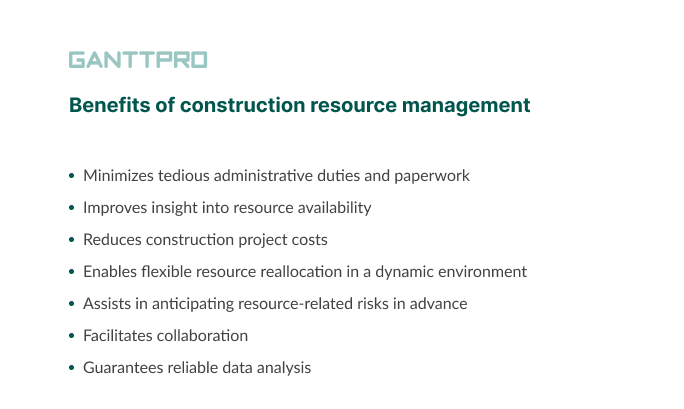
- Minimizes tedious administrative duties and paperwork. Resource management often keeps up with the rise of administrative responsibilities and physical reports, particularly if project managers do not utilize modern PM solutions. Restricting access to construction data can impede swift decision-making in response to sudden changes. With advanced resource allocation in construction project management, employees can easily get important data about all available assets.
- Improves insight into resource availability. Team members need to visualize all their construction assets in a single location. It is especially beneficial when working with resources on different construction sites. They can observe all available personnel and choose the most suitable employees for their current projects based on job roles, skill sets, and availability.
- Reduces construction project costs. Well-prepared resource management assists in reducing wastage, optimizing asset allocation, and ensuring smart utilization of available work resources. Executives control costs by regularly comparing projected expenses with actual spending. They implement corrective actions when challenges arise and mitigate project risks.
- Enables flexible resource reallocation in a dynamic environment. Regrettably, projects in construction frequently encounter delays. It makes adaptable resource allocation a must-have. By acquiring insights into resource utilization across your organization, you can strategically allocate PM resources to high-demand areas and reassign them if needed in case of possible work delays.
- Assists in anticipating resource-related risks in advance. Managers regularly encounter resource-related issues such as an aging workforce, burnouts, skill obsolescence, unforeseen attrition, and more. If they manage risks timely and utilize robust construction PM software, they get the required resources for work.
- Facilitates collaboration. All people involved in construction should be aware of their duties and responsibilities. Typical construction tasks are interdependent, so individuals must always be on the same page. Effective resource management procedures promote collaboration, contributing to positive team dynamics.
- Guarantees reliable data analysis. Thorough resource planning in construction management facilitates enhanced data gathering and analysis. It leads to valuable insights for forthcoming projects and ongoing enhancement.
Resource allocation processes in construction projects could be considered smooth and flawless if they were not accompanied by obvious challenges.
Common challenges in construction resource management
Сonstruction industry professionals frequently face various resource management challenges. Their direct responsibility is to predict and mitigate these issues as soon as possible.
Here is a list of the most common roadblocks they deal with.

- Insufficient skilled workforce. Well-skilled workers are a crucial factor in the success of any construction project. However, the growing demand for smart construction services leads to a shortage of skilled labor. The factors contributing to this shortage may include retirements among construction professionals, outdated work processes, manual resource allocation in project management, lack of professional construction project management software, and so forth. By the way, in Deloitte’s survey (2023), 82% of participants identified a competitive construction job market and attrition of the workforce as the key challenges their companies face.
- Variations in project scope. Potential changes in a construction scope of work can negatively impact resource efficiency and result in increased workloads. Additionally, these changes may contribute to burnout and turnover among workers tasked with last-minute adjustments. Hence, the core responsibility of managers is to ensure that the scope is well-defined for all individuals involved in a certain construction project.
- Inability to forecast future project needs. When top managers don’t have a clear understanding of the upcoming project opportunities, they may find it challenging to anticipate future project needs and demands. It may lead to difficulties in defining project requirements, such as resource types, quantities, necessary skills, and competencies. As a result, they may be unable to kickstart projects promptly.
- Poor arsenal of resource planning tools. This point logically continues the previous one. In today’s competitive technological landscape, managers must apply robust resource management and scheduling software for construction. Relying on simple spreadsheets only suffices for basic administrative tasks. This approach doesn’t adequately tackle the complexities of resource management in construction projects. Hence, if you are new to the construction PM world and wonder how to manage a construction project step by step, consider carefully choosing the right software solution.
- Inadequate resource utilization. Determining suitable resource management metrics can be difficult. Neglecting proper utilization can result in employee disengagement, reduced morale, and other negative outcomes. Moreover, resources may become more error-prone due to a lack of focus, subsequently failing to meet company standards.
- Weak equipment maintenance. It’s crucial to ensure that machinery and tools are in good working condition to minimize downtime and maximize efficiency. Regular maintenance, inspections, and active repairs are essential to address this challenge effectively.
- Delivery delays. This is also a common construction industry challenge. These delays can result from many factors such as supply chain disruptions, fluctuating demand, logistical issues, and more. They may lead to postponed deliveries of materials and equipment, affecting task dependencies and potentially causing workforce downtime or increased manual work.
- Communication breakdowns. Inefficient communication can impede construction projects. Therefore, one of the important construction project management tips for young leaders is to promote team collaboration and create an atmosphere of trust. If not addressed, communication challenges can negatively affect work management as a whole.
- Environmental concerns. The impact of environmental concerns can also add difficulties in organizing construction resources. Sustainability and eco-friendliness are becoming increasingly important in the construction sphere worldwide.
Predicting and preventing such challenges often requires experience and professional skills. Additionally, as in many professional fields, there are best practices that can help managers feel more confident.
Let’s learn more about these practices.
Best practices in construction resource management
Best practices in construction resource management simplify the efforts of PMs enabling efficient asset allocation, reducing potential risks, improving communication, and ensuring compliance. They can be used as guidelines or tips for all participants involved in resource allocation.
Below we list the main practices and their characteristics.
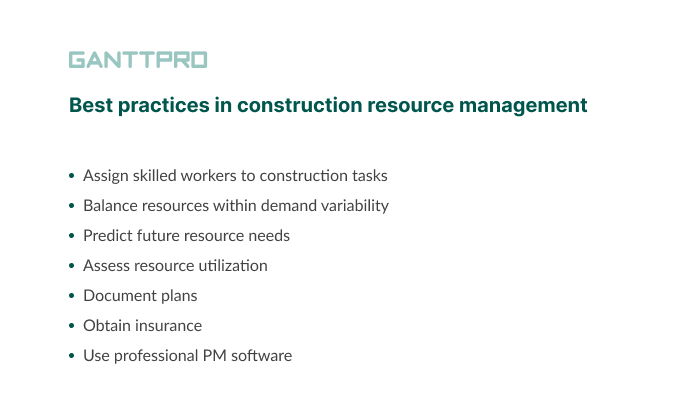
- Assign skilled workers to construction tasks. To guarantee project success and timely completion, PMs should efficiently assign construction resources to tasks based on their attributes. A thorough overview will help them swiftly choose the best-suited workers for each project, ensuring advanced allocation. For instance, if a project demands highly skilled plumbers for complex plumbing tasks, this approach will guarantee the right personnel are chosen.
- Balance resources within demand variability. In the ever-changing construction sphere, fluctuation in labor demand is a usual thing. It can result in a surplus of project resources with no assignments, ultimately impacting the company’s profitability. Nevertheless, by proactively assessing upcoming projects, PMs can effortlessly assign tasks to available assets, minimizing idle time.
- Predict future resource needs. Due to the intricate nature of construction work processes, companies must proactively strategize to ensure the availability of adequate resources when commencing a new project. It means that project managers need to foresee the upcoming asset requirements and assess the skills available within their workforce.
- Assess resource utilization. Sometimes managers may not consistently monitor resource utilization levels. It usually leads to various problems. For example, underutilization of construction workers can affect their morale, while overutilization can lead to burnout, stress, and decreased productivity. To ensure optimal asset utilization, regular control is essential.
- Thoroughly document your plans. Preparing plans with realistic and measurable goals is essential. However, it is even more crucial to document and make these plans visible to ensure the successful completion of your construction work. Such thorough documentation and visibility of plans determine the project’s focus, define its scope, and serve as a knowledge source for all involved in construction.
- Obtain insurance. Insurance is a crucial aspect that should never be underestimated. All construction managers should possess their business liability insurance, which includes coverage for errors and omissions, as well as professional and general liability.
- Consider using professional project management software. One of the fundamental aspects of a successful resource management plan is investing in robust online resource management tools. Modern solutions empower project teams to effectively manage resources, whether they operate in offices or on construction sites. Key features of these project management systems typically include scheduling and planning, task management, resource organization, control of construction workflow, reporting, analytics, and much more.
The last point in this list regarding resource management solutions deserves special attention. So let’s study it in more detail.
The significance of professional software for construction resource management
As you get from the paragraph about the challenges, managing work and resources in the construction field may require meticulous attention to numerous aspects. That is why you need smart software that can do many professional things. This software will help you avoid switching between different tools all the time.
What should the best construction resource management software look like?
It’s great if it streamlines and automates all processes related to asset organization and accelerates proactive team involvement.
One of the nice examples is GanttPRO.
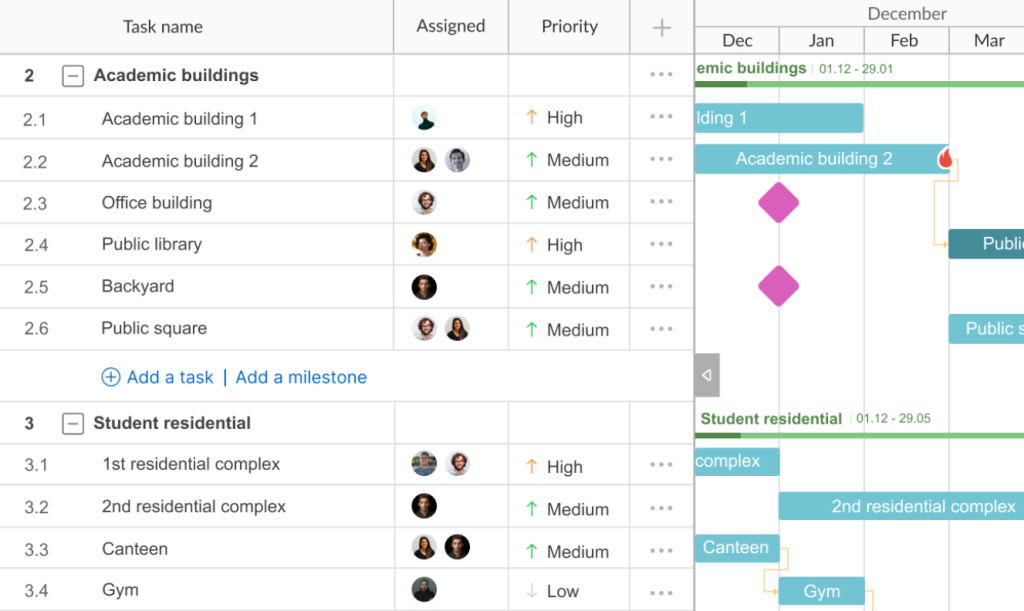
The platform is recognized for its powerful online Gantt chart and a range of professional features that let constructors plan and manage their tasks and resources even within the most complex projects.
Professionals from all over the world highly appreciate this opportunity. One of the experts is George Rossle, a production manager at A+ Construction Pro. He admits:
For us, GanttPRO is a basic tool for planning and management. We use the software for deadline management and time tracking, file sharing, and smart scheduling.
GanttPRO looks equally valuable for different types of construction processes. A handy Gantt chart with resource allocation guarantees that all required resources will be distributed properly and following an initial plan.
Construction objects may be located in different areas and even in several countries. It usually requires mobility and constant control. GanttPRO mobile apps for iOS and Android allow project specialists to be aware of important events, regardless of locations and time zones.
Construction teams choose GanttPRO to plan work, organize tasks, and allocate resources, considering it robust resource management software.
In case you strive to succeed with GanttPRO as quickly as possible, there are handy construction project management templates for use in many construction areas.
Now, with an understanding of GanttPRO functionality, we can dive deeper and explore how it aids in professional resource management in construction.
1. Plan a construction project
Before defining and allocating resources, managers typically establish the overall strategy, project scope, financial aspects, and other critical requirements. These details serve as the basis for generating a comprehensive project management plan.
It is crucial to have a consolidated view of all project activities to assess workload and resource sufficiency. GanttPRO facilitates the creation of project schedules, enabling task breakdown, dependency visualization, and milestone specification.
Consider how a GanttPRO construction project timeline may look like.

2. Visualize required resources
When project tasks are organized, construction PMs look for certain human resources needed for completing project tasks. In GanttPRO, they can invite people and filter them by roles, teams, skills, and more, additionally setting costs and calendars for them.
Visualization of virtual resources on a Gantt diagram takes minutes as well. These types of resources usually include people, buildings, tools, equipment, vehicles, raw materials, etc.

3. Allocate resources
Resource allocation means assigning your project assets or teammates to specific tasks.
In GanttPRO, you can assign one or multiple resources to each task. Thorough resource allocation ensures that you meet all your project objectives.
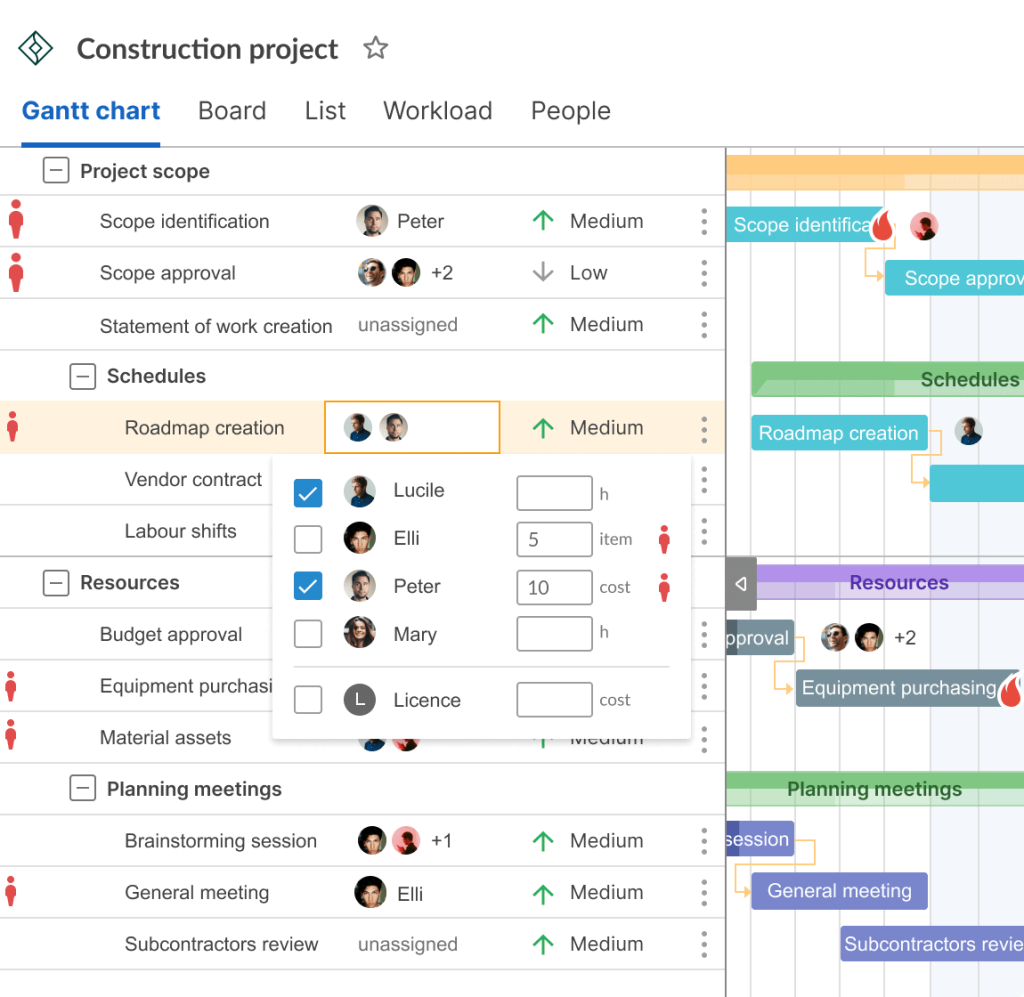
Construction managers should also remember about potential resource shortages or their excesses and take proactive steps to keep things in order. They can apply proven resource allocation methods to resolve asset conflicts and prevent their underutilization or overuse.
The Gantt chart maker allows teams to implement some powerful methods. One of them is a critical path method in construction which helps define and activate a sequence of critical activities that are displayed in red in GanttPRO.
4. Control workload balance
GanttPRO allows for getting an accurate picture of a construction team’s workload providing a high-level overview of assets in long and short terms. Managers can easily control everyone’s availability.
A careful workload analysis helps them instantly spot and minimize overloading or underutilization across the entire team.
Furthermore, workers have the option to log their work hours for specific tasks. This data assists managers in assessing project advancement and resource efficiency.

5. Manage budget and estimate costs
The Gantt chart maker helps teams estimate costs within their projects. It’s pretty easy to plan budgets and monitor project expenses in real time in GanttPRO.
You are allowed to specify costs for all involved assets per hour, per item, or just cost.
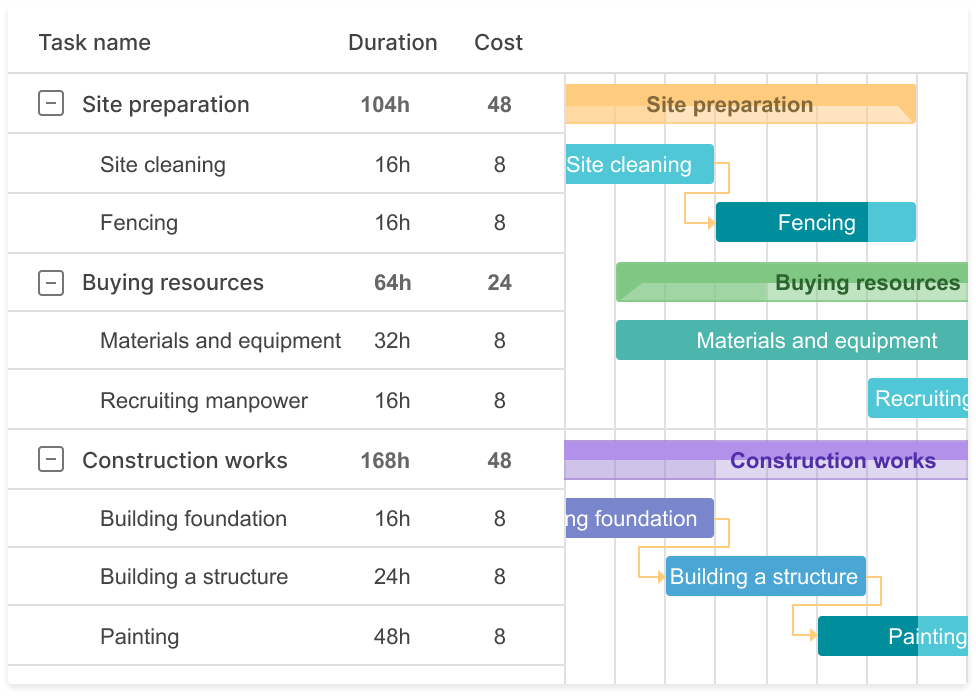
6. Define roles and permissions
Another significant aspect of construction project management is defining roles and permissions.
GanttPRO lets teams determine specific roles and permissions at the account level and also rights and permissions at the project level. It leads to a total understanding of who and when can view, approve, or modify data related to construction works. It guarantees essential security and access management. If required, it’s allowed to include custom roles and permissions.
7. Prepare comprehensive reports
Using GanttPRO, construction workers can consistently remain informed about their projects. They can collect data concerning resource allocation in construction PM and generate thorough reports. It will help them see potential roadblocks to timely adjust plans before it’s too late.
The Gantt chart maker provides two types of reports: time log by people and budget analysis.
8. Collaborate seamlessly
Advanced collaboration features in GanttPRO also have a positive impact on managers’ awareness of the status, quality, and quantity of their resources. They can share construction documents, get notifications, attach files, and improve communication in construction in real time without headaches.
This is actually what the members of the American Institute of Constructors recommend:
Don’t be afraid to use new technologies that can help workers do their jobs more effectively and safely. Utilize new tools and software to streamline communication and collaboration. These platforms offer real-time updates, document sharing, and project tracking, ensuring that project management teams are on the same page.
9. Work with personal calendars
PMs can use personal calendars while assigning tasks to resources. GanttPRO lets them do it effortlessly.
It becomes easy to monitor how many tasks or hours resources have every day. It means that vacations, holidays, and other dates and events are always considered.

Robust resource management software
Complete construction projects on time, manage workloads, and communicate with a team.
Sign up for freeConsider construction resource management a must-have criterion for project success
It seems impossible to complete any construction work without competent specialists, proper equipment, suitable facilities, and other assets.
Advanced resource management in construction, especially enhanced with the power of reliable software, brings clear advantages across a project lifecycle. Thus, comprehending your core requirements and determining optimal resource distribution is crucial.
To make things easier, invest in professional PM tools like GanttPRO to plan, allocate, and control all assets related to your future construction masterpiece.
Read also
Join 800,000+ project managers!
Create Gantt charts in minutes with GanttPRO and reduce time spent on managing tasks by 40%
Try for freeNo credit cards required. No obligation.

